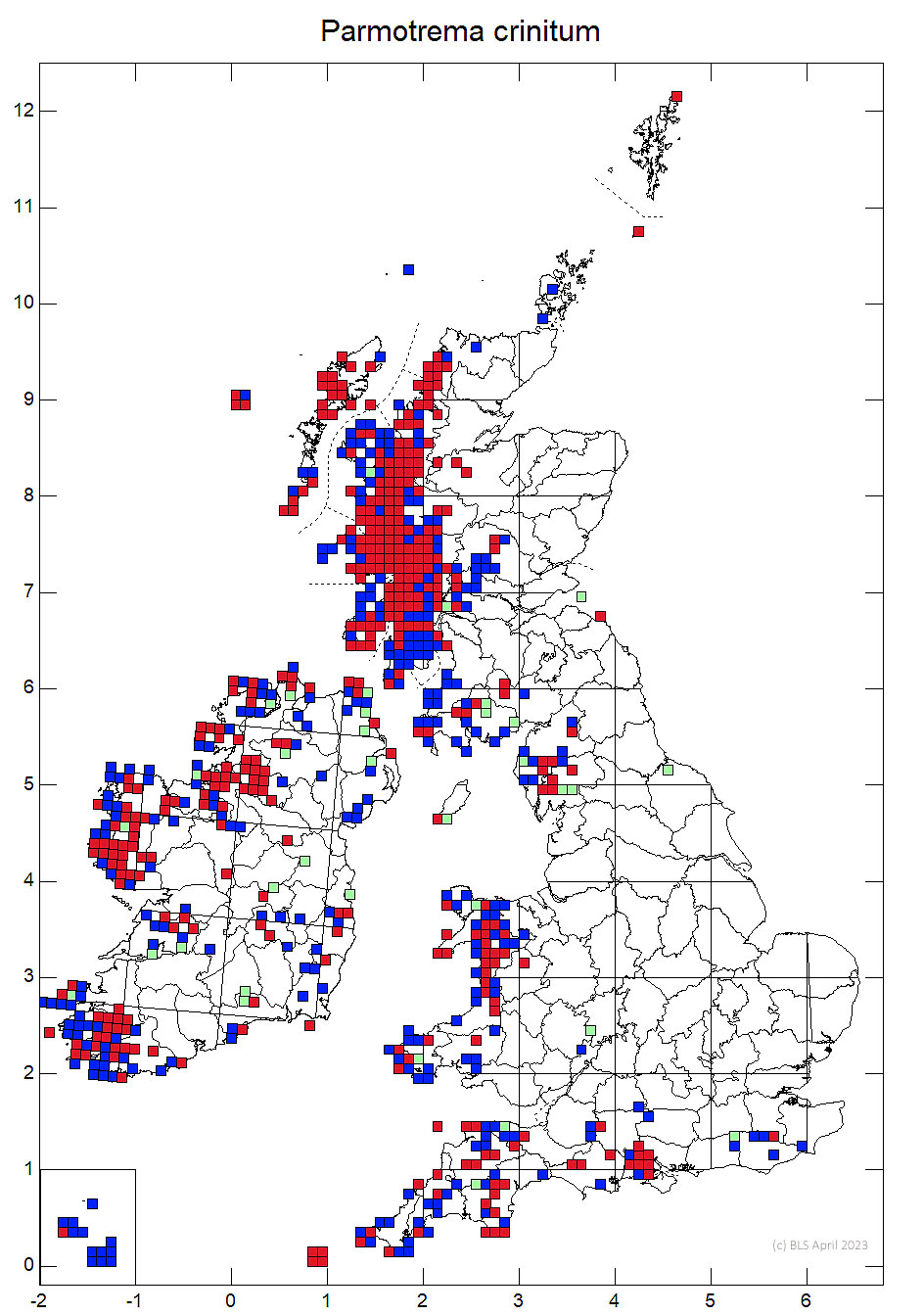A striking bristly Parmotrema, with the nickname "Desperate Dan", after the unshaven appearance given by the ciliate isidia. Hypotrachyna horrescens also has ciliate isidia but is distinguished by the smaller thallus, a lower surface that is rhizinate to the margins and by the K– yellow medulla. A widespread oceanic lichen typically found in old woodlands, frequent in western Scotland, but becoming scarce to the south.
Thallus loosely attached, large, 5–15 (–20) cm diam., often forming extensive patches; lobes sublinear to subirregular, 5–10 (–15) mm wide, broadly rounded at the apices, contiguous but often overlapping and becoming crowded centrally; margins often ascending, wavy and often incised, irregularly lobulate or isidiate; marginal cilia usually associated with incisions; upper surface grey or grey-green, matt, ± faintly maculate, smooth or small-pitted towards the centre; isidia fragile, marginal and laminal, cylindrical or lobulate, becoming coralloid-branched, brown-tipped and frequently with accompanying black cilia, sometimes forming very dense clusters centrally; lower surface black with a broad, brown marginal zone lacking rhizines; rhizines dense, unbranched. Apothecia very rare, submarginal, stalked, 3–8 mm diam.; disk imperforate, thalline margin isidiate. Ascospores 21–31 × 11–15 μm. Pycnidia rare, not reported for British or Irish material. Cortex K+ yellow; medulla C–, K+ yellow, KC+ yellow-orange, Pd+ yellow-orange, UV– [atranorin, stictic (major), constictic acids (minor) and a range of accessory compounds including menegazziaic acid].
Readily distinguished from other Parmotrema species by the ciliate isidia. Hypotrachyna horrescens also has ciliate isidia but is distinguished by the smaller thallus and the lower surface that is rhizinate to the margins and by the K– yellow medulla (stictic acid).
Stelate et al. (2022) found that samples of P. crinitum and P. perlatum clustered in a single lineage with closely similar ITS sequences, but that phylogenetic relationships among them remained unresolved.
On ± mossy bark of mature or old broad-leaved trees and mossy siliceous rock outcrops in sheltered ancient woodland and exposed situations. It is characteristic of well-lit acidic habitats and, occasionally Lobarion communities, in undisturbed sites, also on well-lit rocks, in cliff-top heaths near coasts and on Calluna stems in windswept but misty coastal areas.

An oceanic species widespread in the western uplands, rare in the south and very rare to absent in E. and C. England, and in E. Scotland. Declining and near-extinct in the southern lowlands except in the New Forest where it is thriving.
Widespread and not under threat in western Scotland, but populations are smaller and more stressed to the south. It is assessed as Near Threatened in Wales and appears to have been lost from most lowland English sites, except in the New Forest, where it is still thriving. In lowland England most losses appear to have been from increasing shade within woodlands. In the New Forest it thrives best on glade edge trees within actively grazed pasture woodlands.
Britain: Least concern
Wales: Near Threatened
Cannon, P., Divakar, P., Yahr, R., Aptroot, A., Clerc, P., Coppins, B., Fryday, A., Sanderson, N. & Simkin, J. (2023). Lecanorales: Parmeliaceae, including the genera Alectoria, Allantoparmelia, Arctoparmelia, Brodoa, Bryoria, Cetraria, Cetrariella, Cetrelia, Cornicularia, Evernia, Flavocetraria, Flavoparmelia, Hypogymnia, Hypotrachyna, Imshaugia, Melanelia, Melanelixia, Melanohalea, Menegazzia, Montanelia, Nesolechia, Parmelia, Parmelina, Parmeliopsis, Parmotrema, Platismatia, Pleurosticta, Protoparmelia, Pseudephebe, Pseudevernia, Punctelia, Raesaenenia, Tuckermannopsis, Usnea, Vulpicida and Xanthoparmelia. Revisions of British and Irish Lichens 33: 1-98.
Stelate, A., Del Prado, R., Alors, D., Tahiri, H., Divakar, P.K. & Crespo, A. (2022). Resolving the phylogenetic relationship between Parmotrema crinitum and Parmotrema perlatum populations. Lichenologist 54: 183–194.
Text by N A Sanderson, based on Cannon et al (2023).



